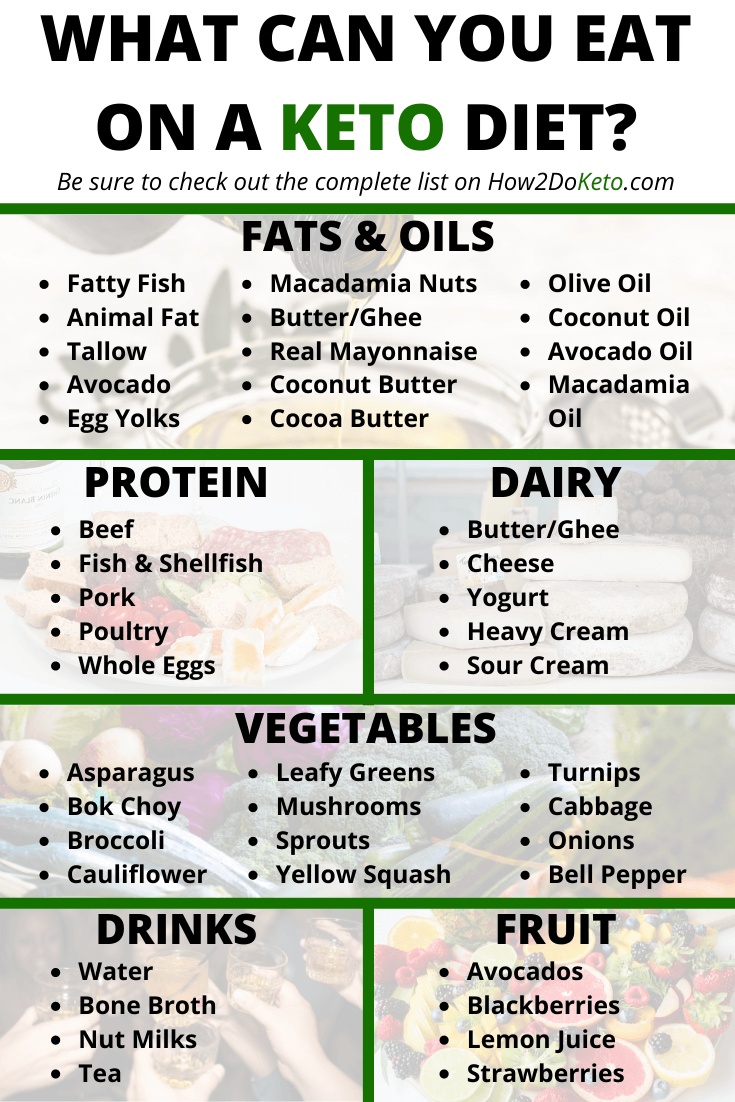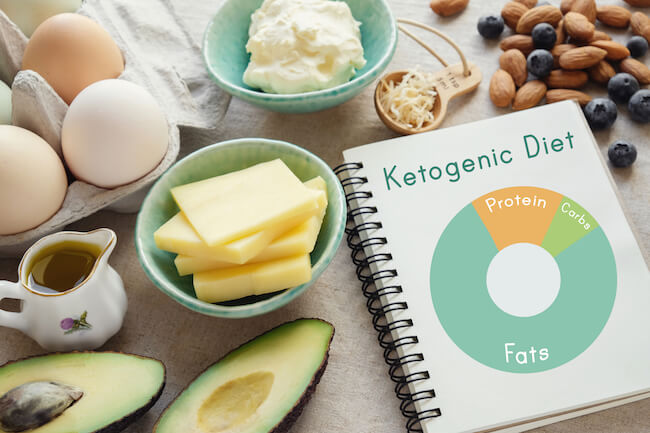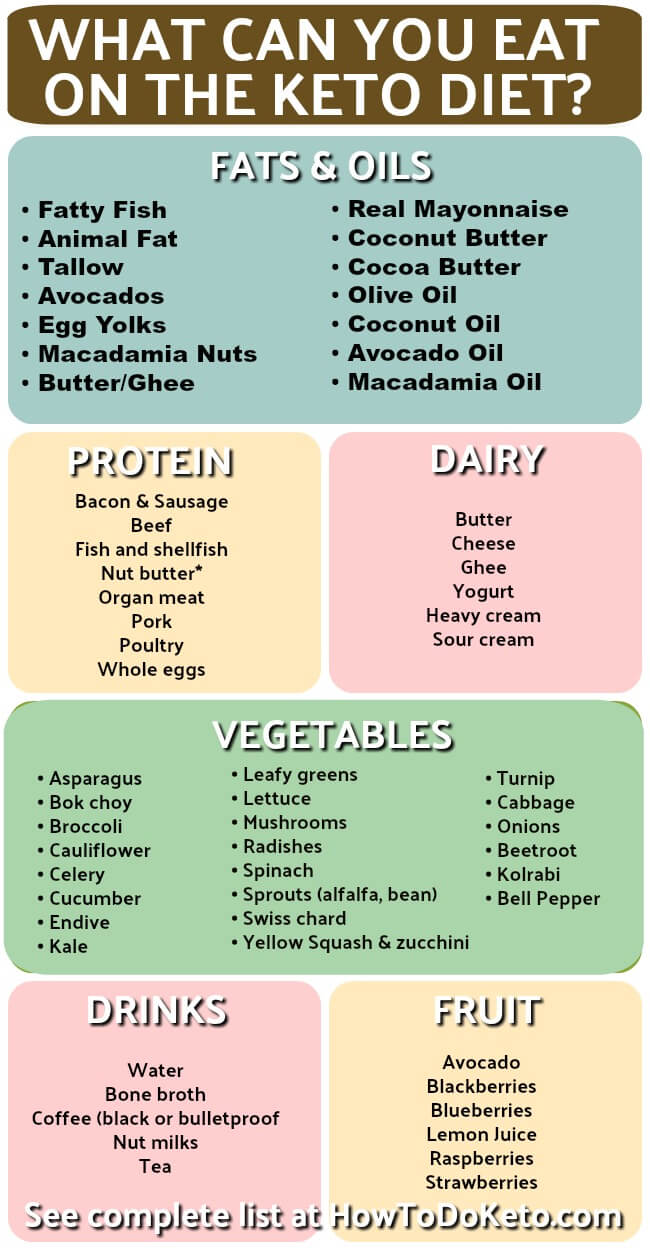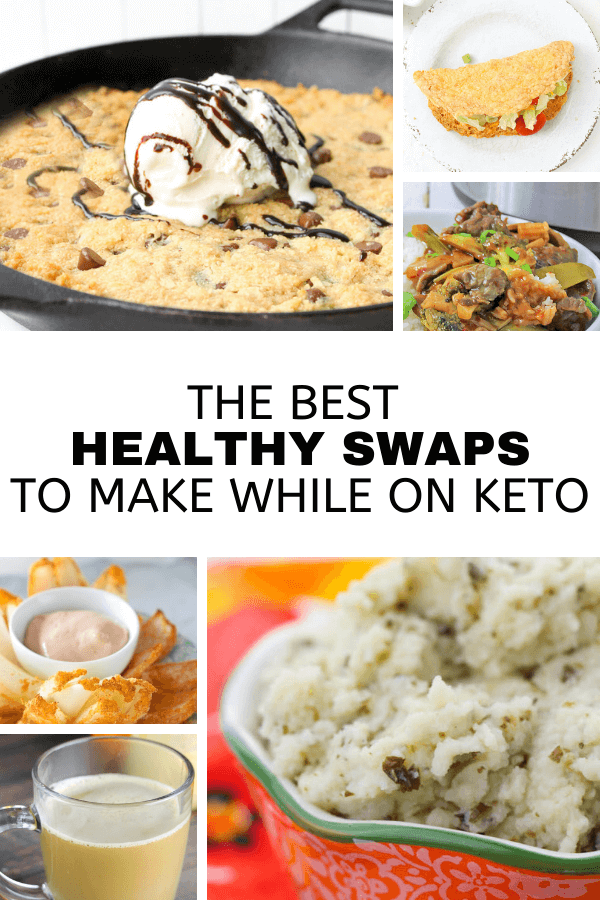Wondering what foods you can eat on the Keto Diet? Bookmark our keto food list for an easy at-a-glance guide to starting a ketogenic diet!
When starting the keto diet, it can be a bit confusing trying to figure out what you’re “allowed” to eat.
High fat, low carb is the general strategy, but not all fats are good and not all carbs are bad. Plus, there are different interpretations as far as how many carbs you can eat on keto.
And that is where things get tricky!
What Foods Can You Eat on the Keto Diet?
We’ve tried to make figuring out what foods can you eat on the keto diet as simple as possible, by breaking it down into categories:
- Fats & Oils
- Protein
- Vegetables
- Fruits
- Dairy
- Beverages
- Sweeteners, Spices, etc.

Keto Food List
You may notice overlap with the lists, as some food items fit into more than one category. It’s also not a 100% all-inclusive list of keto-friendly foods, but it should give you a good idea of where to start.
Fats & Oils
The keto diet is a high-fat, low carb diet, so it goes without saying that good fats should make up a big chunk of what you eat.
Why fats?
When in a state of ketosis, your body burns fats for energy, so it’s important to supply your body with the fuel it needs.
There aren’t a lot of limitations with fats, except to stay away from processed options.
Eat these:
- Fatty Fish (like salmon)
- Animal Fat (non-hydrogenated)
- Lard
- Tallow
- Avocados
- Egg Yolks
- Macadamia/Brazil Nuts
- Butter/Ghee
- Mayonnaise (check labels for fillers or make your own keto mayonnaise)
- Coconut Butter
- Cocoa Butter
- Olive Oil
- Coconut Oil
- Avocado Oil
- Macadamia Oil
- MCT Oil
Avoid these:
- Anything containing trans fats
- Hydrogenated oils
- Processed oils (sunflower, safflower, cottonseed, canola, soybean, grapeseed, or corn oil)
Protein
Protein is an important part of any diet, though with a ketogenic diet you want to be sure not to over-consume protein. This is because excessive protein intake can increase glucose production and slow your progress.
One trick is to balance out the protein in your meals with sides and condiments that are higher in fat content. However, unless you are intentionally adding extra protein to your diet (outside of each meal), you probably don’t have to worry.
In contrast with what many traditional diets preach, on a keto diet it is encouraged to look for fattier cuts of meat.
- Bacon (always check labels, avoid added fillers and sugar-cured options)
- Beef
- Fish and seafood
- Nut butter*
- Organ meat
- Pork
- Poultry
- Shellfish
- Sausage (always check labels, avoid added fillers and sugars)
- Whole eggs
A note about peanut butter:
The mention of peanut butter often brings up controversy in the keto world. In my research and personal experience, peanut butter in moderation fits perfectly into a low carb lifestyle – it contains both good fats AND protein.
Always stick to natural peanut butter and avoid anything with added sugars to make sure your peanut butter is keto-compliant. Also be mindful of your total carbs for the day when indulging, as 2 Tablespoons of peanut butter contains 4 grams net carbs. If it fits in your daily allowance, you should be fine.
Like anything else, if you notice that the addition of a particular food slows your progress, that may be a food you want to limit. This will be different for everyone.
Read More: Can You Eat Peanut Butter on the Keto Diet?

Vegetables
When it comes to vegetables, focus on finding nutrient-dense options. Dark, leafy greens are low in carbs and rich in nutrients, so they are a must on any diet, keto or not.
When incorporating vegetables from the “moderation” list, you simply need to make sure that these fit within your total carb allowance for the day. If you’re on a strict low carb diet, you may want to choose fewer things from this list.
Stay away from starchy vegetables, which can pack tons of carbohydrates. For example, one medium potato contains a whopping 32 grams of net carbs, which may be more that your entire daily allotment!
Eat lots of these:
- Asparagus
- Avocado (yes, technically a fruit but I’ve included it here too)
- Bell Pepper
- Bok choy
- Broccoli
- Cauliflower
- Celery
- Collard greens
- Cucumber
- Endive
- Kale
- Kohlrabi
- Leafy greens
- Lettuce
- Mushrooms
- Radishes
- Spinach
- Sprouts (alfalfa, bean)
- Swiss chard
- Yellow Squash
- Zucchini
Enjoy in moderation:
- Artichoke
- Bamboo shoots
- Beetroot
- Bitter melon
- Brussel sprouts
- Cabbage
- Celery root
- Eggplant
- Fennel
- Garlic
- Green beans
- Jicama
- Leeks
- Nori (seaweed)
- Okra
- Olives
- Onion
- Parsnips
- Pumpkin
- Rhubarb
- Rutabaga
- Sugar snap peas
- Sweet potato
- Tomatillo
- Tomato
- Turnip
- Water chestnuts
- Winter squash (acorn, butternut, spaghetti)
Skip these:
- Carrots
- Corn
- Parsnips
- Peas
- Potatoes
- Yams
- Yucca
Notice that many of the starchy vegetables listed above grow underground – while not 100% inclusive, this is a helpful trick to determine which vegetables are not ideal on a keto diet.
Learn More: 14 Vegetables to Avoid on Keto
Fruits
Vegetables are generally more nutritious than fruits, so don’t worry about “missing” anything if you limit or cut out fruits.
Eat lots of these:
- Avocados
Rich in good fats and low in net carbs, avocados are pretty much the only fruit you are supposed to eat freely on a keto diet.
Try this recipe: Cucumber Avocado & Pomegranate Salad
Enjoy in moderation:
- Blackberries
- Blueberries
- Raspberries
- Strawberries
These berries provide benefits like antioxidants, though they contain a fair amount of carbs. While definitely better for you than a traditional dessert, you’ll want to limit your intake.
To get your fruit fix, try this recipe: Keto Raspberry Almond Shortbread Cookies
Lemons are another option that may be used in moderation for flavoring recipes (like our Keto Lemon Mug Cake) or water. There are about 4 grams net carbs in 1/4 cup of lemon juice, so like anything else, you’ll simply want to keep that in mind for your daily carb count.
Skip these:
- Apples
- Bananas
- Grapes
- Mangoes
- Oranges
- Papaya
- Pineapple
- Tangerines
Related: Click here for a full list of fruits you can eat on the keto diet!
Dairy
When eating dairy on a keto diet, always choose full fat options. Fat-free and low-fat dairy items should be avoided at all costs – when removing fat, it is usually replaced with sugars or other fillers.
If dairy is not an option for you, it is possible to get plenty of protein and healthy fats from other sources.
Enjoy these:
- Butter
- Cheese
- Ghee
- Yogurt
- Heavy cream
- Sour cream
Avoid these:
- Fat-free and/or low fat anything (butter substitutes, cream cheese, cottage cheese, yogurt, etc.)
- Milk (skim, 2%)
- Shredded or processed cheese (these often contain fillers)
Related: Click here for an amazing Keto Cheese Chips recipe!
Beverages
The keto diet can be a diuretic, so it’s important to drink water and stay hydrated!
Drink these:
- Water
- Tea (unsweetened)
- Coffee (bulletproof coffee or black)
- Bone broth
- Nut milks, in moderation as they contain some carbs
Avoid these:
- Juice
- Milk
- Alcohol
- Any drink with added sugar
Alcohol is not entirely forbidden on the keto diet; however, some studies show that alcohol can slow fat metabolism substantially. If you choose to drink, do so in moderation and stick to dry wine or distilled liquors without any added sugar.
Spices, Sweeteners, Etc.
Enjoy these:
- Erythritol
- Inulin
- Monk fruit
- Pure liquid sucralose
- Stevia
- Unsweetened chocolate or cocoa powder
Related: What are the best keto sweeteners? Click for our TOP pick!
Most spices should be fine on a keto diet – just be sure to avoid spice mixes that contain sugar or additives.
Use in moderation:
- Maltitol
- Xylitol
These are sugar alcohols and may cause digestive issues and discomfort. I personally avoid these like the plague!
While erythritol is also a sugar alcohol, it functions a bit differently and much fewer side effects. Studies show that erythritol is mostly absorbed into the bloodstream before it reaches the colon. However, I’d still advise using it in moderation.
Avoid these:
- Agave syrup
- Aspartame
- Acesulfame
- Fructose
- Honey
- Maple Syrup
- Sorbitol
- Saccharin
- Sugar
A Final Word…
Keep in mind that this is not a 100% all-inclusive list. We tried to be as complete as possible, but there are likely a few things that are not on our keto food list that are indeed keto-friendly.
Also, some items on this list may not be appropriate for every person. If there are any items on this keto food list that you know cause you inflammation, discomfort, or you are allergic too, please avoid them.
Related: Is Keto Healthy for Women?
If you notice anything that you think should be on our keto food list that isn’t, feel free to let us know in the comments below! We’ll update as often as possible!
Read this next: How many carbs can you have on a keto diet?

Get the FREE printable
Fill out the form below to get our extended shopping list delivered right to your inbox! By signing up for our newsletter, you’ll also get recipes, tips, and more!
Want to know more? Check out this big list of keto food swaps too!



Pingback: Keto Egg Salad Wraps - Only 1g Net Carbs! - How 2 Do Keto
Briliant!! I am new to keto, and this is really a helpful blog. I am still deciding what to put in my shopping cart to start my keto meal plan. Thanks for this awesome keto food list!!! 🙂 I am so excited to start this new eating ways!!
Keto diet is the bomb! Keep up the good work.
Great blog. However, Sucralose is a dangerous artificial sweetener. You have aspartame on your “avoid list” and sucralose should be right there with it.
Leafy vegetables are loaded with nutrients and they’re keto-friendly. There s kale, spinach, bok choy, Swiss chard, collards, watercress, mizuna, and arugula. Dig in.
I am new to keto, just trying to figure out what to buy at the grocery and recipes , have a few questions,,, I’m assuming that bread ,pancakes, cereal, and pizza is all out of the foods that we eat. What can you eat for breakfast? We have biscuits and gravy ,cereal toast and have pizza a couple times a week and hamburgers and hot dogs, and spaghetti with salad and garlic bread,are these all completely a nono now?
Hi Sherry – On the keto diet, you’re looking to lower your carb intake dramatically and instead consume more good fats and some protein. You can still enjoy some of your favorite foods, but you’ll need to modify them or find a keto-friendly version. For example, try burgers “animal style” where you use lettuce wraps instead of buns. For breakfast, my husband and I eat a lot of eggs, bacon, etc. Sometimes I’ll do tacos with almond flour tortillas or a sweet potato hash. Since I’m close to my goal weight, I do eat a small amount of carbs for energy – usually earlier in the day and then I eat lunch or dinner with very few carbs to balance things out. Hope this helps!
Hi. The article mentioned that there are things not on the lists that are keto friendly. Why cant the not be listed separately?
I do enjoy whole grains but do not eat them every day. Would they be keto friendly as long as I did not eat over a certain amount?
What can substitute for cottage cheese?
Cottage cheese is ok in moderation if you use full-fat cottage cheese (with no added sugars).